I bear in mind being a starting yoga scholar stumbling by way of vinyasa lessons, feeling I used to be all the time one step behind. In fact, yoga academics usually give detailed cues to accommodate novices of their lessons, however it may be overwhelming as soon as the tempo picks up as you progress by way of a sequence.
That’s why I’m an enormous advocate of working towards yoga at dwelling, so you may take your time to discover new poses, perceive correct kind, and turn out to be aware of how every asana feels in your physique.
Prolonged Aspect Angle Pose, or Utthita Parsvakonasana, is a posture that comes up very often in varied types of yoga, so this can be a essential pose to know. Many yoga academics like myself contemplate it a cornerstone in constructing partaking yoga sequences. This asana is a spotlight of many Vinyasa flows — a dynamic step that integrates power and suppleness, benefiting all the physique.
That will help you really feel extra assured in your subsequent yoga session, I’ll information you thru the nuances of this highly effective asana, full with cues for correct kind, methods to change and improve the pose, and concepts for incorporating Lengthen Aspect Angle Pose into your property yoga routine.
Plus, I’ll throw in some must-know yogi info about this potent posture’s background, anatomy, and advantages.
Be a part of me for this deep dive into considered one of my favourite poses, Prolonged Aspect Angle! Seize your mat, and let’s get into it!
Foundations of Utthita Parsvakonasana
Categorised within the class of standing poses, Prolonged Aspect Angle is a contemporary asana that emerged within the twentieth century. T. Krishnamacharya’s Yoga Makaranda (1934) launched this pose with temporary directions. His scholar B.Ok.S. Iyengar provided extra detailed step-by-step directions in his 1966 textual content Gentle on Yoga.
In my instructing, I really like to incorporate this asana in dynamic flows paired with different strengthening yoga poses. However you too can observe Prolonged Aspect Angle independently, holding the pose to construct power and stamina.
The Sanskrit identify itself unfolds a library of knowledge concerning the physique’s potential motion in house:
- Utthita: Lifted or prolonged
- Parsva: Aspect
- Kona: Angle
- Asana: Pose
Put all of it collectively, and the identify affords an ideal visible description of this asana: your whole physique is prolonged and open to 1 facet, creating an angular form. Now, let’s get into observe Prolonged Aspect Angle.
Step-by-Step Directions for Utthita Parsvakonasana
A strong base is essential for Prolonged Aspect Angle Pose. The stance will likely be acquainted to you in case you’ve performed Warrior II or Triangle Pose earlier than. When you be taught the precise positioning of your ft, you’ll be able to circulate.

Setting Up
To get into Prolonged Aspect Angle Pose:
- Stand in the midst of your mat, going through the lengthy edge. Step your ft wider than your hips.
- Pivot in your heel to show your proper foot 90 levels so your toes level towards the entrance fringe of your mat.
- Flip your left foot in the identical course about 45 levels.
Create the Aspect Angle Form
- Bend your entrance proper leg, making a 90-degree angle along with your proper knee.
- Maintain your again left leg straight and floor down by way of the outer fringe of the left foot.
- Bend out of your waist over your entrance bent knee.
Higher Physique Place
- Start by bringing your proper forearm to your proper thigh.
- Lengthen your left arm up and ahead along with your bicep subsequent to your ear.
- Stack your left shoulder over your proper so your chest and torso stay open.
- Straighten your proper elbow and attain your proper arm all the way down to the skin of your entrance foot. Press the fingertips of your proper hand into the ground, or convey your palm flat.
- Maintain your left ear going through the sky to align your head and neck with the backbone.
On this place, it’s best to really feel one lengthy line alongside the left facet of your physique, from the left foot by way of your fingertips.
Exiting Prolonged Aspect Angle
- Interact your core, particularly the obliques, to return your torso upright.
- Straighten your proper leg and switch the toes of each ft to face the opposite manner.
- Repeat Utthita Parsvakonasana going through the opposite manner, bending your left knee whereas preserving your proper leg straight, and reaching your proper arm up and over your head.
Transfer mindfully by way of every step, bringing consciousness to which muscle tissue are engaged and dealing versus lengthening and opening.
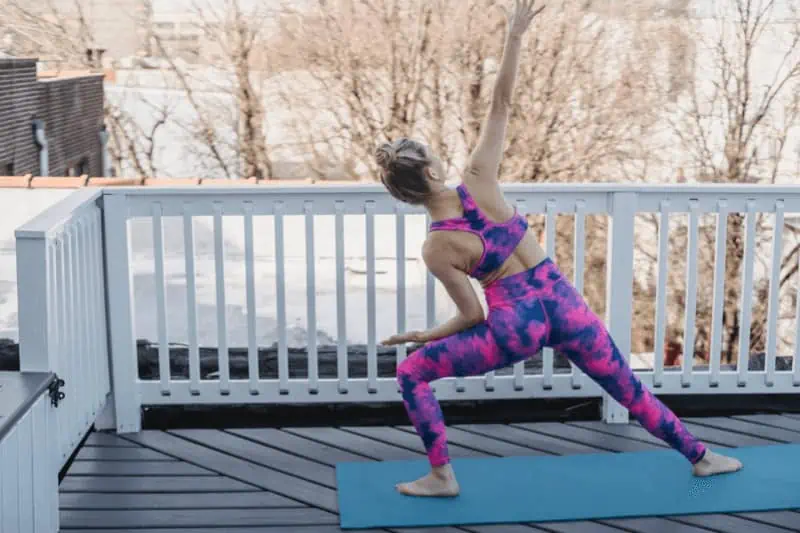
Refine Your Alignment
Now that you know the way to enter and exit Utthita Parsvakonasana, let’s take a extra detailed look. Yoga academics can use these cues to make sure college students interact the precise muscle tissue and forestall accidents. In case you are working towards yoga alone, use the following pointers to assist construct your physique consciousness.
Full-Physique Focus
Prolonged Aspect Angle is a implausible lower-body strength-builder, however that’s not the one factor happening with this pose. Along with your entrance leg supporting your weight and you are feeling your thigh muscle tissue beginning to burn, don’t neglect about your chest and shoulders!
The magic of this pose is its balancing impact: by making a sturdy base along with your decrease half, your torso is free to increase and open.
Frequent Errors and Methods to Repair Them
Listed here are among the most typical errors I see when instructing Utthita Parsvakonasana. Avoiding these misalignments will assist you interact the precise muscle tissue to get essentially the most out of the pose.
- Entrance knee falling: Folks usually let their bent knee drift inward. Maintain it aligned with the second toe of your entrance foot.
- Shoulders scrunching: Keep house between your shoulders and ears, drawing your shoulder blades down and throughout your again.
- Torso rolling ahead: I’ve seen a bent to permit the highest shoulder and hip to roll ahead as the highest arm reaches ahead. Maintain your hips stacked and your shoulders aligned vertically.
- Core collapsing: Some college students let their backside arm bear all their weight within the palm on the ground or the forearm on prime of the thigh. Use your arm for assist and stability, however use your indirect muscle tissue to raise your torso.
- Again heel lifting: Collapsing the interior arch of the again foot by lifting the heel can pressure the knee. As an alternative, press down by way of the skin fringe of the again foot.
Breath Consciousness for Elevated Stamina
Sustaining regular respiratory may help enhance focus and stamina throughout this intense stretch. I all the time discover that specializing in my breath throughout a difficult asana permits me to carry poses longer.
Strive it for your self! When your thigh muscle tissue begin burning throughout Prolonged Aspect Angle, give your thoughts one thing else to consider by shifting your consideration to your breath. You would possibly be capable of maintain the pose 5, 10, or 20 seconds longer every time. This system is an effective way to construct power steadily.
Modifications for Prolonged Aspect Angle Pose
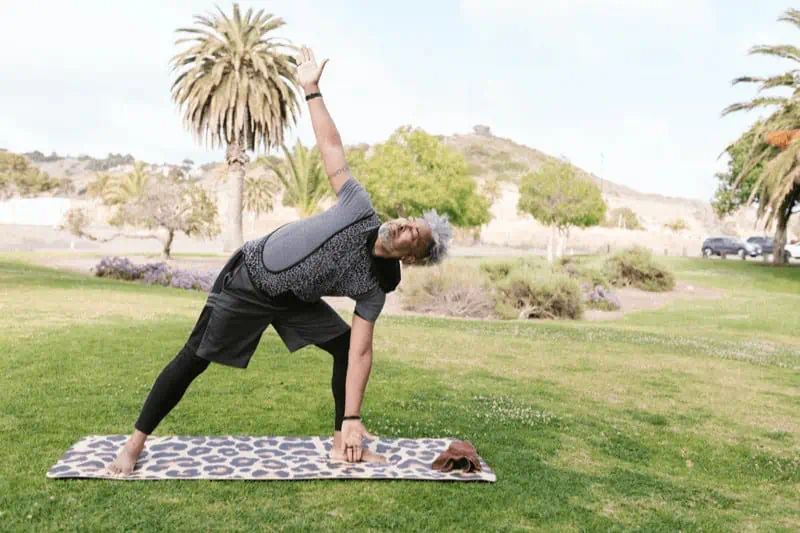
Yoga is an adaptable, individualized observe. For those who discover the standard model of this asana difficult, there are many methods to change the pose to make it give you the results you want.
Utilizing props within the Prolonged Aspect Angle Pose ensures right kind. This helps if reaching the ground is difficult for you or in case you are engaged on constructing power. These changes cater to various talent ranges, power, mobility, and physique proportions and assist stop harm.
Block Help
Use a block to convey the bottom nearer to you in case you can’t attain the ground comfortably.
- Place a block beneath your backside hand to the within or exterior of your entrance foot.
- Regulate the block’s top to fit your consolation stage and arm size.
This easy modification creates a extra secure basis, permitting you to pay attention extra in your stance. I like to recommend this block from lululemon!

lululemon’s Elevate and Lengthen Yoga Block
Chair Modification for Prolonged Aspect Angle Pose
Utilizing a chair for assist in Utthita Parsvakonasana makes this pose extra accessible in case you lack leg power or have problem balancing.
- Place your self in entrance of a chair with the seat underneath your entrance thigh. As you bend your entrance knee, convey your leg to relaxation on the chair’s seat.
- Convey your forearm onto your thigh and attain your different arm in the direction of the sky.
To steadily construct power, interact your hamstrings and thigh muscle tissue and raise your self off the chair, hovering a few inches above the seat. Maintain for just a few seconds, then launch again all the way down to the chair. Repeat 3 to five instances on each legs. Over time, you’ll discover your muscle tissue getting stronger.
Modifications for All
There are a number of methods to change Prolonged Aspect Angle Pose. When you’ve got shoulder points, strive resting your forearm in your thigh as an alternative of reaching down along with your hand. This reduces the compression in your shoulder joint.
Some yoga academics cue this asana with the pinnacle turned in the direction of the higher arm. If this feels uncomfortable in your neck, hold your gaze straight forward. Personally, I favor to maintain my head aligned with my backbone.
For those who’re a newbie, strive a number of of those recommendations to find what feels the most effective in your physique. That’s the great thing about yoga — you may nearly all the time alter the yoga poses to make them work in your talents.

Prolonged Aspect Angle Pose for All Ranges
In fact, modifications aren’t only for novices. There are many methods to change yoga poses to problem your self.
Half-Sure Chest-Opener
Intermediate yogis can deepen their stretch in Prolonged Aspect Angle Pose with a half-bind to open the chest and shoulders.
- Attain your prime arm towards the sky. Bend your elbow and let your forearm drape behind your decrease again.
- Work on inching your fingers towards your decrease hip.
- Roll your prime shoulder again and open your armpit towards the sky. Squeeze your shoulder blades collectively.
- Shift your gaze up. Maintain the stretch and breathe deeply. Once you’re prepared, launch the bind and attain your arm up.
I really like this model of the pose for the expansive feeling of opening the chest and sides of the rib cage. I all the time really feel I can breathe deeper after this half-bound Aspect Angle variation.
Sure Prolonged Aspect Angle
Up for a critical problem? Strive taking a full bind in your Aspect Angle Pose.
- Drape your higher arm throughout your decrease again as you’ll in a half-bind.
- Let your backside shoulder drop decrease in entrance of your bent knee.
- Internally rotate your backside arm, bending your elbow to achieve underneath your entrance leg.
- Clasp the fingers of each arms collectively. Work to roll your prime shoulder again so your chest stays open.
This model requires appreciable power in your core, interior thighs, quadriceps, and hamstrings. However in case you interact all the right muscle tissue, you should not have any downside preserving your self balanced whereas holding the bind.
Preparatory Poses for Utthita Parsvakonasana
Earlier than making an attempt the Prolonged Aspect Angle Pose, it’s essential to heat up. Correct preparation can considerably improve your flexibility and cut back the possibility of muscle pressure.
Heat-Up Poses
Begin with poses that put together your muscle tissue for Utthita Parsvakonasana. A number of efficient warm-up poses embody:
Every pose targets vital areas used within the Prolonged Aspect Angle Pose. These yoga postures stretch and strengthen your legs, arms, and core.
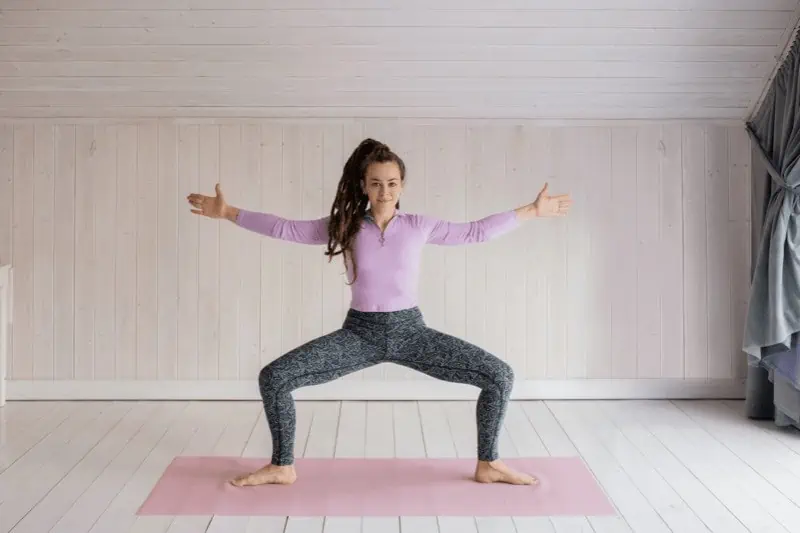
Enhancing Mobility
The preparatory poses usually are not random; they’re chosen to enhance flexibility the place you want it most for the posture. For instance, Goddess opens up the hips, stretches the interior thighs, and prompts the quadriceps. This makes reaching a deeper bend in Utthita Parsvakonasana simpler.
Strive holding every preparatory pose for at the very least 5 breaths, permitting your muscle tissue to launch rigidity steadily.
Conscious Transitions
Transferring mindfully between asanas is as necessary because the poses themselves. That’s one other perception behind these rigorously chosen preparatory poses. You’ll be able to circulate easily between Large-Legged Ahead Fold, Goddess, and Warrior II.
Your legs will really feel strong and able to assist you in holding your Prolonged Aspect Angle Pose. Sustaining stability is one thing I emphasize when instructing yoga as a result of it reinforces a strong basis for any sequence of actions.
Anatomy and Well being Advantages of Utthita Parsvakonasana
Impacted Muscle Teams
Prolonged Aspect Angle Pose targets a number of muscle teams. Right here’s an summary of every little thing being lengthened and strengthened on this asana:
- Stretching: hip (psoas), interior thighs, intercostal muscle tissue
- Strengthening: quadriceps, hamstrings, knees, ankles, core, and again (quadratus lumborum)
- Totally different variations can also strengthen the underside arm and shoulder or open the chest.
In my expertise, studying extra concerning the anatomy of yoga postures helped me really feel extra related to my observe. Realizing the mechanics of an asana encourages targeted consideration on muscle engagement and exact positioning, growing physique consciousness and proprioception. I like to recommend this e book.

Yoga Mat Companion 1: Anatomy for Vinyasa Movement and Standing Poses
Further Well being Advantages
This pose affords quite a few different well being advantages moreover firming and stretching varied muscle teams.
- Builds steadiness, particularly when taking the gaze up towards the fingertips
- Improves posture by strengthening the again muscle tissue, mobilizing the backbone, and opening the chest
- Stimulates digestion because of the mild compression across the belly organs as you lean over your entrance leg
- Boosts power and circulation; as a dynamic posture, you’ll get your blood flowing and enhance respiration
- Calms and focuses the thoughts, because of the deep respiratory required on this asana
Energy, Stamina, and Self-Confidence
Constant observe of prolonged facet angle builds power and stamina. Over time, holding this pose longer turns into extra manageable as your muscle tissue adapt. You might even discover your endurance improves throughout different bodily actions.
In fact, growing power and stamina requires a excessive stage of self-discipline and self-determination. However the payoff is value it, as you’ll construct confidence in your self and your talents alongside the best way.
The psychological fortitude you domesticate in intense asanas like Prolonged Aspect Angle Pose can increase your psychological and emotional well-being.
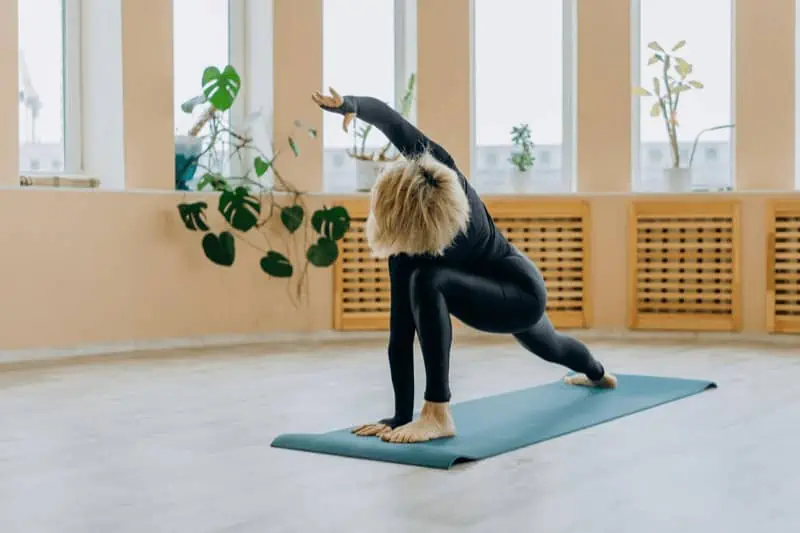
Enhancing Your Observe with Variations and Sequencing
Utthita Parsvakonasana turns into extra dynamic when utilized in sequences. As a standing pose, quite a few yoga poses pair completely with Utthita Parsvakonasana.
Sequencing Concepts
A well-planned sequence can easily combine Utthita Parsvakonasana into your vinyasa circulate. Listed here are a few my go-to sequences using this pose. These mini-flows improve stability and suppleness whereas emphasizing breath consciousness.
- Start in Warrior II. Exhale to Prolonged Aspect Angle. Return to Warrior II in your subsequent inhale. Exhale into Reverse Warrior. Repeat this sequence, flowing along with your breath.
- Start in Utthita Parsvakonasana. As you exhale, transfer into Triangle Pose by straightening your entrance knee. Inhale and return to Prolonged Aspect Angle. Movement between these two positions, shifting along with your breath.
Exploring Deeper Variations of the Pose
Including variations of Utthita Parsvakonasana to your sequences opens up new potentialities for inventive transitions.
- From the certain variation of Utthita Parsvakonasana, you may enter Chicken of Paradise, a difficult standing asana balancing on one leg with the opposite gracefully prolonged.
- Within the full expression of Utthita Parsvakonasana, with the palm of your backside hand urgent into the ground, transition to Aspect Plank by stepping your entrance foot again.
I really like spicing up my lessons with inventive yoga sequences and difficult transitions like these. Diversifying your yoga routine with new actions doesn’t solely progress your bodily observe — it’s a exercise in your mind, too!
Conclusion
Some yoga poses serve a specific function, concentrating on one particular muscle group. Others, like Prolonged Aspect Angle Pose, verify many packing containers. Need to construct power? Stretch? Launch rigidity? This pose can do all of it!
Variations of Utthita Parsvakonasana work varied muscle teams for an all-around health expertise. Even merely altering arm positions can shift the exercise from legs to arms to core, making this an extremely versatile yoga pose. Throw in some props and modifications, and this asana turns into accessible to yogis of all ranges.
Take your time to turn out to be aware of the basics of this pose, as it’s a cornerstone in lots of yoga sequences. When you’re comfy within the asana, let the creativity circulate alongside along with your actions, and take a look at pairing Utthita Parsvakonasana with associated yoga poses.
I encourage you to combine this highly effective asana into your routine, embracing its variations to maintain your observe dynamic and fascinating. Replicate on the steadiness between effort and ease as you achieve this.
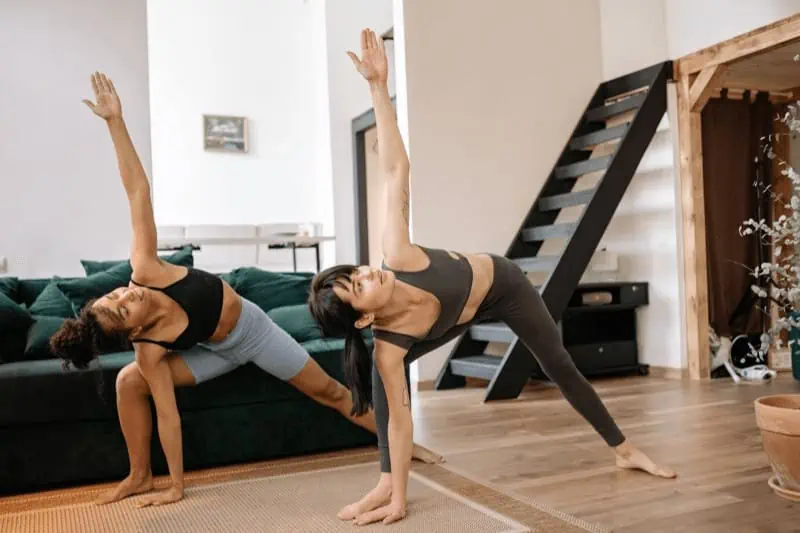
Continuously Requested Questions
What’s Utthita Parsvakonasana?
Utthita Parsvakonasana, also called Prolonged Aspect Angle Pose, is a standing yoga pose that emphasizes stretching the edges of the physique and strengthening the legs.
Who can profit from working towards Utthita Parsvakonasana?
People trying to improve flexibility, power, and steadiness can profit from working towards Utthita Parsvakonasana. It’s notably helpful for athletes, dancers, and people who interact in sports activities that require robust legs and a secure core.
Is Prolonged Aspect Angle Pose appropriate for novices?
Sure, Prolonged Aspect Angle Pose is appropriate for novices, but it surely needs to be approached with care. Freshmen can use modifications similar to inserting the decrease hand on a block as an alternative of reaching for the ground. Freshmen have to deal with correct alignment moderately than reaching depth.
Who ought to keep away from working towards Utthita Parsvakonasana?
People with coronary heart circumstances, hypertension, or accidents to the hips, knees, again, or shoulder ought to seek the advice of a healthcare supplier earlier than making an attempt Utthita Parsvakonasana.
What are the frequent errors to keep away from in Utthita Parsvakonasana?
Frequent errors embody compromising the alignment by bending the torso in the direction of the ground or letting the entrance knee collapse inward. Moreover, inserting an excessive amount of weight on the hand resting on the bottom or a block might compress the shoulder joint.
How usually ought to I observe this asana?
The frequency of observe can range relying on particular person health ranges and private objectives, however incorporating this pose into your routine a number of instances per week may help you enhance flexibility and power.

